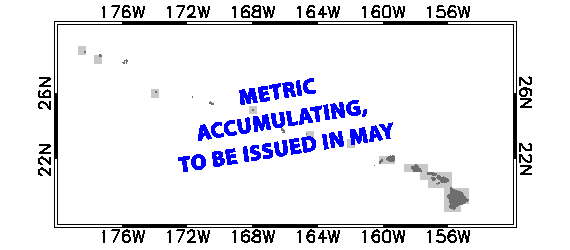(Version 2, released June 11, 2019)
(Accumulating for May - November 2025)
 |
 Current Summer Outbreak Risk
|
 |
 |
 |
| Download Data (netCDF): HTTPS site FTP site |
| Product Metadata: | Web-format Metadata | XML Metadata | Plain Text Metadata |
The Winter Cold Snap metric accumulates anomalously cold temperatures through time, as compared with the usual historical range of winter temperatures (winter climatology). It quantifies the risk that an area will experience an unusually cold event (Winter Cold Snap). Extreme cold periods can result in a reduction in pathogen loading that leads to subsequent coral disease.
The Winter Conditions metric accumulates temperature anomalies during the cold season, as compared with the average temperature observed in the three coldest months (i.e., winter) at each location. It represents the variation of the current cold season from the average condition. Mild winters (colored in shades of blue in the Winter Conditions maps above) have been linked to subsequent outbreaks of White Syndrome disease in corals. Research has shown that such outbreaks do not occur following anomalously cool winters (colored in shades of brown in the Winter Conditions maps above) or anomalously warm winters (colored in shades of green). This is likely related to a reduction in disease pathogen abundance and an increase in host resistance, respectively.
The Summer Hot Snap metric accumulates anomalously hot temperatures through time, as compared with the usual range of summer temperatures (summer climatology). This provides an indication of unusually hot events, and represents the level of heat stress (ranging from low to high in the Summer Hot Snap maps above) that corals experience.
The Seasonal Outlook (or Winter Pre-Conditioning) metric is based only on the cold season metrics. It provides a measure of the pre-disposition of corals to a disease outbreak during the following warm season. Only locations that experienced mild winters (colored in shades of blue in the Winter Conditions maps) are considered to be at-risk, with the likelihood of a coral disease outbreak defined by the presence/absence of unusually cold events (see the Winter Cold Snap metric). The Seasonal Outlook metric value is issued at the end of the cold season, providing a 3-6 month forecast of the likelihood of a coral disease outbreak.
The Current Summer Outbreak Risk metric is assigned only for locations that experienced mild winters (colored in shades of blue in the Winter Conditions maps), and is defined by the level of heat stress (Summer Hot Snap metric) experienced during the subsequent warm period. If an area of the Current Summer Disease Outbreak Risk map is colored from yellow to red, it indicates a significant likelihood of coral disease occurring, increasing linearly with the color scale. This metric is updated in near real-time during each region's warm season.
| Product Metadata: | Web-format Metadata | XML Metadata | Plain Text Metadata |
Reference: Heron S.F., B.L. Willis, W.J. Skirving, C.M. Eakin, C.A. Page, I.R. Miller (2010). Summer Hot Snaps and Winter Conditions: Modelling White Syndrome Outbreaks on Great Barrier Reef Corals, PLoS One.
![]() The Version 2 Coral Disease Outbreak Risk product metrics on this page
(available since June 11, 2019, and hindcast from January 1, 1985) are
derived using the NOAA CRW daily global 5km-resolution CoralTemp sea surface
temperature (SST) product. Version 2 product development was supported
with funding from the NOAA Coral Reef Conservation Program (CRCP).
Additional improvements to and expansion of this product are being funded
by the NOAA CRCP and by the
NASA Ecological Forecasting Program (Applied Sciences
Program)
The Version 2 Coral Disease Outbreak Risk product metrics on this page
(available since June 11, 2019, and hindcast from January 1, 1985) are
derived using the NOAA CRW daily global 5km-resolution CoralTemp sea surface
temperature (SST) product. Version 2 product development was supported
with funding from the NOAA Coral Reef Conservation Program (CRCP).
Additional improvements to and expansion of this product are being funded
by the NOAA CRCP and by the
NASA Ecological Forecasting Program (Applied Sciences
Program)![]() , through the
University of Hawai'i-Hawai'i Institute of Marine
Biology
, through the
University of Hawai'i-Hawai'i Institute of Marine
Biology![]() .The NASA Ecological Forecasting
Program-funded effort is being conducted in close collaboration with
James Cook University
.The NASA Ecological Forecasting
Program-funded effort is being conducted in close collaboration with
James Cook University![]() ,
the University of Newcastle
,
the University of Newcastle![]() ,
and the University of New South Wales
,
and the University of New South Wales![]() ,
and is part of the multi-year Fore-C project, "Forecasting Coral disease
outbreaks across the tropical Pacific Ocean using satellite-derived data".
The goal of the proposed research is to develop better models of coral
disease outbreak risk across the western tropical Pacific Ocean and embed
these improved forecasts into the NOAA CRW
decision support system for coral reef ecosystem management.
,
and is part of the multi-year Fore-C project, "Forecasting Coral disease
outbreaks across the tropical Pacific Ocean using satellite-derived data".
The goal of the proposed research is to develop better models of coral
disease outbreak risk across the western tropical Pacific Ocean and embed
these improved forecasts into the NOAA CRW
decision support system for coral reef ecosystem management.